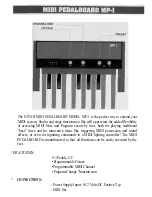
CLP-380 Owner’s Manual
31
Basic Operation
Recording Your Performance
This chapter explains how to record your performance using the Clavinova recording
function.
You can, for example, play back what you have played on the Clavinova keyboard for an
effective practice aid. You can also record just the left-hand part, then practice the right-
hand part while playing back the recorded left-hand part.
Since you can record up to sixteen parts separately, you could record the left- and right-
hand parts separately, or record each part of a four-handed performance or ensemble
song one by one to build a song.
Recording vs. Saving:
The format of performance data recorded on a cassette tape differs from that of data recorded on the Clavinova. A
cassette tape records audio signals. On the other hand, the Clavinova “saves” information regarding note timing,
voices, and a tempo value, but not audio signals. When you play back recorded songs, the Clavinova produces
sound based on the saved information. Therefore, recording on the Clavinova may be more accurately called
“saving information.” However, this book often uses the word “recording” because it seems to make more sense.
A message (information or confirmation dialog) sometimes appears on the screen to
facilitate operation. Refer to the “Message List” on page 104 for an explanation of each
message, appropriate actions to take, and troubleshooting information.
There are two ways to record your performance: recording it quickly without specifying a recording part, or recording
several different parts to multiple parts. You can select whichever way best suits your purpose.
■
Recording a performance without specifying the recording part
(page 32)
This convenient and simple recording method lets you quickly record your performance
without specifying the recording parts—useful, for example, in recording solo piano pieces.
In this way, the performance is automatically recorded to part 1 (right part).
■
Recording a performance of several different parts (page 35)
This lets you record the right, left and extra parts separately. Since you can record the left part
while playing back the right, this is useful for recording both parts of a duet. Since you can
record up to sixteen parts separately, record the performance of each instrument part one by
one and create fully orchestrated compositions.
You can record your performance
(audio data) to a cassette tape
recorder or other recording devices
via the AUX OUT connector. (See
page 73.)
TIP
TERMINOLOGY
Recording a New Song
Appropriate channels (parts) in the
song will automatically be assigned
to [RIGHT] and [LEFT]. Therefore,
[RIGHT] may be assigned to a part
other than Part 1, or [LEFT] to a
part other than Part 2.
If a “MemoryFull” message or
“SystemLimit” message appears
after recording your performance,
refer to the section “Saving
recorded songs to a USB storage
device ... [Save]” on page 42.
TIP
TIP
EXTRA PARTS
LEFT
RIGHT
[RIGHT] corresponds to part 1.
Record the right-hand part to [RIGHT].
[LEFT] corresponds to part 2.
Record the left-hand part to [LEFT].
[EXTRA PARTS] corresponds to part 3 – 16.
Record parts 3-16 in addition to part 1 and 2
when you are recording a song which has
many parts, such as a symphony orchestra.
Part 1
Part 2
Part 3
Part 4
Part 16
Summary of Contents for CLAVINOVA C L P - 3 8
Page 132: ...CLP 380 Owner s Manual 132 Memo ...
Page 133: ...CLP 380 Owner s Manual 133 Memo ...
















































